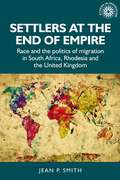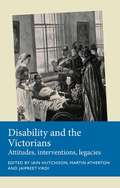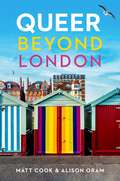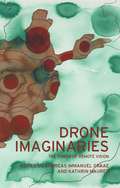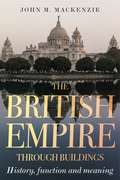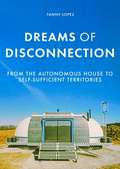- Table View
- List View
Settlers at the end of empire: Race and the politics of migration in South Africa, Rhodesia and the United Kingdom (Studies in Imperialism #193)
by Jean SmithSettlers at the end of empire traces the development of racialised migration regimes in South Africa, Rhodesia (present-day Zimbabwe) and the United Kingdom from the Second World War to the end of apartheid in 1994. While South Africa and Rhodesia, like other settler colonies, had a long history of restricting the entry of migrants of colour, in the 1960s under existential threat and after abandoning formal ties with the Commonwealth they began to actively recruit white migrants, the majority of whom were British. At the same time, with the 1962 Commonwealth Immigrants Act, the British government began to implement restrictions aimed at slowing the migration of British subjects of colour. In all three nations, these policies were aimed at the preservation of nations imagined as white, revealing the persistence of the racial ideologies of empire across the era of decolonisation.
Settlers at the end of empire: Race and the politics of migration in South Africa, Rhodesia and the United Kingdom (Studies in Imperialism #193)
by Jean SmithSettlers at the end of empire traces the development of racialised migration regimes in South Africa, Rhodesia (present-day Zimbabwe) and the United Kingdom from the Second World War to the end of apartheid in 1994. While South Africa and Rhodesia, like other settler colonies, had a long history of restricting the entry of migrants of colour, in the 1960s under existential threat and after abandoning formal ties with the Commonwealth they began to actively recruit white migrants, the majority of whom were British. At the same time, with the 1962 Commonwealth Immigrants Act, the British government began to implement restrictions aimed at slowing the migration of British subjects of colour. In all three nations, these policies were aimed at the preservation of nations imagined as white, revealing the persistence of the racial ideologies of empire across the era of decolonisation.
The politics of hunger: Protest, poverty and policy in England, <i>c.</i> 1750–<i>c.</i> 1840
by Carl GriffinThe 1840s witnessed widespread hunger and malnutrition at home and mass starvation in Ireland. And yet the aptly named ‘Hungry 40s’ came amidst claims that, notwithstanding Malthusian prophecies, absolute biological want had been eliminated in England. The eighteenth and early nineteenth centuries were supposedly the period in which the threat of famine lifted for the peoples of England. But hunger remained, in the words of Marx, an ‘unremitted pressure’. The politics of hunger offers the first systematic analysis of the ways in which hunger continued to be experienced and feared, both as a lived and constant spectral presence. It also examines how hunger was increasingly used as a disciplining device in new modes of governing the population. Drawing upon a rich archive, this innovative and conceptually-sophisticated study throws new light on how hunger persisted as a political and biological force.
The politics of hunger: Protest, poverty and policy in England, <i>c.</i> 1750–<i>c.</i> 1840
by Carl GriffinThe 1840s witnessed widespread hunger and malnutrition at home and mass starvation in Ireland. And yet the aptly named ‘Hungry 40s’ came amidst claims that, notwithstanding Malthusian prophecies, absolute biological want had been eliminated in England. The eighteenth and early nineteenth centuries were supposedly the period in which the threat of famine lifted for the peoples of England. But hunger remained, in the words of Marx, an ‘unremitted pressure’. The politics of hunger offers the first systematic analysis of the ways in which hunger continued to be experienced and feared, both as a lived and constant spectral presence. It also examines how hunger was increasingly used as a disciplining device in new modes of governing the population. Drawing upon a rich archive, this innovative and conceptually-sophisticated study throws new light on how hunger persisted as a political and biological force.
EcoGothic gardens in the long nineteenth century: Phantoms, fantasy and uncanny flowers
by Sue EdneyEcoGothic gardens in the long nineteenth century provides fresh approaches to contemporary ecocritical and environmental debates, providing new, compelling insights into material relationships between vegetal and human beings. Through twelve exciting essays, the collection demonstrates how unseen but vital relationships among plants and their life systems can reflect and inform human behaviours and actions. In these entertaining essays, human and vegetal agency is interpreted through ecocritical and ecoGothic investigation of uncanny manifestations in gardens – hauntings, psychic encounters, monstrous hybrids, fairies and ghosts – with plants, greenhouses, granges, mansions, lakes, lawns, flowerbeds and trees as agents and sites of uncanny developments. The collection represents the forefront of ecoGothic critical debate and will be welcomed by specialists in environmental humanities at every level, as a timely, innovative inclusion in ecoGothic studies.
EcoGothic gardens in the long nineteenth century: Phantoms, fantasy and uncanny flowers
by Sue EdneyEcoGothic gardens in the long nineteenth century provides fresh approaches to contemporary ecocritical and environmental debates, providing new, compelling insights into material relationships between vegetal and human beings. Through twelve exciting essays, the collection demonstrates how unseen but vital relationships among plants and their life systems can reflect and inform human behaviours and actions. In these entertaining essays, human and vegetal agency is interpreted through ecocritical and ecoGothic investigation of uncanny manifestations in gardens – hauntings, psychic encounters, monstrous hybrids, fairies and ghosts – with plants, greenhouses, granges, mansions, lakes, lawns, flowerbeds and trees as agents and sites of uncanny developments. The collection represents the forefront of ecoGothic critical debate and will be welcomed by specialists in environmental humanities at every level, as a timely, innovative inclusion in ecoGothic studies.
Disability and the Victorians: Attitudes, interventions, legacies (Disability History)
by Martin Atherton Iain Hutchison Jaipreet VirdiDisability and the Victorians brings together in one collection a range of topics, perspectives and experiences from the Victorian era that present a unique overview of the development and impact of attitudes and interventions towards those with impairments during this time. The collection also considers how the legacies of these actions can be seen to have continued throughout the twentieth century right up to the present day. Subjects addressed include deafness, blindness, language delay, substance dependency, imperialism and the representation of disabled characters in popular fiction. These varied topics illustrate how common themes can be found in how Victorian philanthropists and administrators responded to those under their care. Often character, morality and the chance to be restored to productivity and usefulness overrode medical need and this both influenced and reflected wider societal views of impairment and inability.
Disability and the Victorians: Attitudes, interventions, legacies (Disability History)
by Julie AndersonDisability and the Victorians brings together in one collection a range of topics, perspectives and experiences from the Victorian era that present a unique overview of the development and impact of attitudes and interventions towards those with impairments during this time. The collection also considers how the legacies of these actions can be seen to have continued throughout the twentieth century right up to the present day. Subjects addressed include deafness, blindness, language delay, substance dependency, imperialism and the representation of disabled characters in popular fiction. These varied topics illustrate how common themes can be found in how Victorian philanthropists and administrators responded to those under their care. Often character, morality and the chance to be restored to productivity and usefulness overrode medical need and this both influenced and reflected wider societal views of impairment and inability.
Queer beyond London
by Matt Cook Professor Alison OramWhen it comes to queer British history, London has stolen the limelight. But what about the millions of queer lives lived elsewhere? In Queer beyond London, two leading LGBTQ+ historians take you on a journey through four English cites from the sixties to the noughties, exploring the northern post-industrial heartlands and taking in the salty air of the seaside cities of the South. Covering the bohemian, artsy world of Brighton, the semi-hidden queer life of military Plymouth, the lesbian activism of Leeds, and the cutting edge dance and drag scenes of Manchester, they show how local people, places and politics shaped LGBTQ+ life in each city, forging vibrant and distinctive queer cultures of their own. Using pioneering community histories from each place, and including the voices of queer people who have made their lives there, the book tells local stories at the heart of our national history.
Queer beyond London
by Matt Cook Professor Alison OramWhen it comes to queer British history, London has stolen the limelight. But what about the millions of queer lives lived elsewhere? In Queer beyond London, two leading LGBTQ+ historians take you on a journey through four English cites from the sixties to the noughties, exploring the northern post-industrial heartlands and taking in the salty air of the seaside cities of the South. Covering the bohemian, artsy world of Brighton, the semi-hidden queer life of military Plymouth, the lesbian activism of Leeds, and the cutting edge dance and drag scenes of Manchester, they show how local people, places and politics shaped LGBTQ+ life in each city, forging vibrant and distinctive queer cultures of their own. Using pioneering community histories from each place, and including the voices of queer people who have made their lives there, the book tells local stories at the heart of our national history.
Drone imaginaries: The power of remote vision
by Andreas Immanuel Graae and Kathrin MaurerThere should no longer be any doubt: drones are here to stay. In civil society, they are used for rescue, surveillance, transport and leisure. And on the battlefield, their promises of remote protection and surgical precision have radically changed the way wars are fought. But what impact are drones having on our identity, and how are they affecting the communities around us? This book addresses these questions by investigating the representation of civilian and military drones in visual arts, literature, and architecture. What emerges, the contributors argue, is a compelling new aesthetic: ‘drone imaginary’, a prism of cultural and critical knowledge, through which the complex interplay between drone technology and human communities is explored, and from which its historical, cultural and political dimensions can be assessed. The contributors offer diverse approaches to this interdisciplinary field of aesthetic drone imaginaries. With essays on the aesthetic configurations of drone swarming, historical perspectives on early unmanned aviation, as well as current debates on how drone technology alters the human body and creates new political imaginaries, this book provides new insights to the rapidly evolving field of drone studies. Working across art history, literature, photography, feminism, postcolonialism and cultural studies, Drone imaginaries offers a unique insight into how drones are changing our societies.
Drone imaginaries: The power of remote vision
by Andreas Immanuel Graae Kathrin MaurerThere should no longer be any doubt: drones are here to stay. In civil society, they are used for rescue, surveillance, transport and leisure. And on the battlefield, their promises of remote protection and surgical precision have radically changed the way wars are fought. But what impact are drones having on our identity, and how are they affecting the communities around us? This book addresses these questions by investigating the representation of civilian and military drones in visual arts, literature, and architecture. What emerges, the contributors argue, is a compelling new aesthetic: ‘drone imaginary’, a prism of cultural and critical knowledge, through which the complex interplay between drone technology and human communities is explored, and from which its historical, cultural and political dimensions can be assessed. The contributors offer diverse approaches to this interdisciplinary field of aesthetic drone imaginaries. With essays on the aesthetic configurations of drone swarming, historical perspectives on early unmanned aviation, as well as current debates on how drone technology alters the human body and creates new political imaginaries, this book provides new insights to the rapidly evolving field of drone studies. Working across art history, literature, photography, feminism, postcolonialism and cultural studies, Drone imaginaries offers a unique insight into how drones are changing our societies.
The British Empire through buildings: Structure, function, meaning
by John M. MacKenzieBuildings provide tremendous insights into the character of imperialism, not least in the manner in which Western forms were spread across the globe. They reveal the projection of power and authority in colonised landscapes, as well the economic ambitions and social and cultural needs of colonial peoples in all types of colonies. They also represent a colonial order of social classes and racial divisions, together with the ways in which these were inflected through domestic living space, places of work and various aspects of cultural relations. They illuminate the desires of Europeans to indulge in cultural and religious proselytisation, encouraging indigenous peoples to adopt western norms. But the resistance of the supposedly subordinate people led to the invasion, adoption and adaptation of such buildings for a post-colonial world. The book will be vital reading for all students and scholars interested in the widest aspects of material culture.
The British Empire through buildings: Structure, function, meaning
by John M. MacKenzieBuildings provide tremendous insights into the character of imperialism, not least in the manner in which Western forms were spread across the globe. They reveal the projection of power and authority in colonised landscapes, as well the economic ambitions and social and cultural needs of colonial peoples in all types of colonies. They also represent a colonial order of social classes and racial divisions, together with the ways in which these were inflected through domestic living space, places of work and various aspects of cultural relations. They illuminate the desires of Europeans to indulge in cultural and religious proselytisation, encouraging indigenous peoples to adopt western norms. But the resistance of the supposedly subordinate people led to the invasion, adoption and adaptation of such buildings for a post-colonial world. The book will be vital reading for all students and scholars interested in the widest aspects of material culture.
Imperial nostalgia: How the British conquered themselves (G - Reference,information And Interdisciplinary Subjects Ser.)
by Peter MitchellA strong emotional attachment to the memory of empire runs deep in British culture. In recent years, that memory has become a battleground in a long-drawn ideological war, inflecting debates on race, class, gender, culture, the UK’s future and its place in the world. This provocative and passionate book surveys the scene of the imperial memory wars in contemporary Britain, exploring how the myths that structure our views of empire came to be, and how they inform the present. Taking in such diverse subjects as Rory Stewart and inter-war adventure fiction, man’s facial hair and Kipling, the Alt-right and the Red Wall, Imperial Nostalgia asks how our relationship with our national past has gone wrong, and how it might be improved.
Border images, border narratives: The political aesthetics of boundaries and crossings (Rethinking Borders)
by Sarah Green Hastings DonnanThis interdisciplinary volume explores the role of images and narratives in different borderscapes. Written by experienced scholars in the field, Border images, border narratives provides fresh insight into how borders, borderscapes, and migration are imagined and narrated in public and private spheres. Offering new ways to approach the political aesthetics of the border and its ambiguities, this volume makes a valuable contribution to the methodological renewal of border studies and presents ways of discussing cultural representations of borders and related processes. Influenced by the thinking of philosopher Jacques Rancière, this timely volume argues that narrated and mediated images of borders and borderscapes are central to the political process, as they contribute to the public negotiation of borders and address issues such as the in/visiblity of migrants and the formation of alternative borderscapes. The contributions analyse narratives and images in literary texts, political and popular imagery, surveillance data, border art, and documentaries, as well as problems related to borderland identities, migration, and trauma. The case studies provide a highly comparative range of geographical contexts ranging from Northern Europe and Britain, via Mediterranean and Mexican-USA borderlands, to Chinese borderlands from the perspectives of critical theory, literary studies, social anthropology, media studies, and political geography.
Border images, border narratives: The political aesthetics of boundaries and crossings (Rethinking Borders)
by Sarah Green Hastings DonnanThis interdisciplinary volume explores the role of images and narratives in different borderscapes. Written by experienced scholars in the field, Border images, border narratives provides fresh insight into how borders, borderscapes, and migration are imagined and narrated in public and private spheres. Offering new ways to approach the political aesthetics of the border and its ambiguities, this volume makes a valuable contribution to the methodological renewal of border studies and presents ways of discussing cultural representations of borders and related processes. Influenced by the thinking of philosopher Jacques Rancière, this timely volume argues that narrated and mediated images of borders and borderscapes are central to the political process, as they contribute to the public negotiation of borders and address issues such as the in/visiblity of migrants and the formation of alternative borderscapes. The contributions analyse narratives and images in literary texts, political and popular imagery, surveillance data, border art, and documentaries, as well as problems related to borderland identities, migration, and trauma. The case studies provide a highly comparative range of geographical contexts ranging from Northern Europe and Britain, via Mediterranean and Mexican-USA borderlands, to Chinese borderlands from the perspectives of critical theory, literary studies, social anthropology, media studies, and political geography.
The reputation of philanthropy since 1750: Britain and beyond
by Hugh CunninghamMost people now associate philanthropy with donations of money by the rich to good causes. It has not always been so. The Reputation of Philanthropy explores how our modern definition came about and asks why praise for philanthropy and philanthropists has always been matched by criticism. Were we really capable of loving all of humankind? Was it possible that what was thought of as philanthropy might create a dependency class and do more harm than good? Was it sensible to focus so much on far away places to the neglect of the poor at home?Deeply researched, timely and accessible, this book will inform today’s thinking about the role that philanthropy should play in British society. The criticisms of philanthropy in the past have telling echoes in the present.
The reputation of philanthropy since 1750: Britain and beyond
by Hugh CunninghamMost people now associate philanthropy with donations of money by the rich to good causes. It has not always been so. The Reputation of Philanthropy explores how our modern definition came about and asks why praise for philanthropy and philanthropists has always been matched by criticism. Were we really capable of loving all of humankind? Was it possible that what was thought of as philanthropy might create a dependency class and do more harm than good? Was it sensible to focus so much on far away places to the neglect of the poor at home?Deeply researched, timely and accessible, this book will inform today’s thinking about the role that philanthropy should play in British society. The criticisms of philanthropy in the past have telling echoes in the present.
How the other half lives: Interconnecting socio-spatial inequalities
by Katie Higgins Samuel BurgumWe are, all of us, intimately familiar with inequalities. Whether finding somewhere to live, walking in the street, following the news, negotiating international travel, or in our working and personal lives, subtle and crude hierarchies shape our lived experience. How the other half lives contributes detailed, multidisciplinary, and qualitative explorations of the everyday social and spatial realities of inequality, drawing new lines from Manchester to Milan, from Brighton to Bologna. Uniquely structured as a series of oppositions between peaks and troughs, with each chapter focusing on a specific subject, including: housing, urban design, place-making, the state, cultures of inequality, and transnational mobility. This book is a resource to navigate an unequal world, oriented around three key understandings of inequality as contingent, intersectional, and interrelated.
How the other half lives: Interconnecting socio-spatial inequalities
by Katie Higgins Samuel BurgumWe are, all of us, intimately familiar with inequalities. Whether finding somewhere to live, walking in the street, following the news, negotiating international travel, or in our working and personal lives, subtle and crude hierarchies shape our lived experience. How the other half lives contributes detailed, multidisciplinary, and qualitative explorations of the everyday social and spatial realities of inequality, drawing new lines from Manchester to Milan, from Brighton to Bologna. Uniquely structured as a series of oppositions between peaks and troughs, with each chapter focusing on a specific subject, including: housing, urban design, place-making, the state, cultures of inequality, and transnational mobility. This book is a resource to navigate an unequal world, oriented around three key understandings of inequality as contingent, intersectional, and interrelated.
Dreams of disconnection: From the autonomous house to self-sufficient territories (Manchester University Press)
by Fanny LopezWhy do we live in homes and communities built around the century-old industrial model of large service networks that use polluting resources? For more than a century, creative architects and planners have dreamed of decentralisation and self-sufficient living, not to cut themselves off from society, but to invent new modes of consumption and to rethink collective public services around common environmental values. In a time of climate crisis, changing society means changing energy infrastructures. Dreams of disconnection tells the story of this strand of design and planning, from its pioneers in the late nineteenth century to those applying similar ideas to tomorrow’s technology two hundred years later. Lopez takes in many a utopian visionary in her tour of dreamers of disconnection, from theorists and architects to industrialists and engineers. Technology and design are the centrepieces for these projects, and their complexity, particularly around sustainable supplies of energy, food and water, so often find solutions in aesthetics. Whether these models were based around single homes or whole cities, Dreams of disconnection reveals that there is much to be learnt and marvelled at in the history of self-sufficient design.
Dreams of disconnection: From the autonomous house to self-sufficient territories (Manchester University Press)
by Fanny LopezWhy do we live in homes and communities built around the century-old industrial model of large service networks that use polluting resources? For more than a century, creative architects and planners have dreamed of decentralisation and self-sufficient living, not to cut themselves off from society, but to invent new modes of consumption and to rethink collective public services around common environmental values. In a time of climate crisis, changing society means changing energy infrastructures. Dreams of disconnection tells the story of this strand of design and planning, from its pioneers in the late nineteenth century to those applying similar ideas to tomorrow’s technology two hundred years later. Lopez takes in many a utopian visionary in her tour of dreamers of disconnection, from theorists and architects to industrialists and engineers. Technology and design are the centrepieces for these projects, and their complexity, particularly around sustainable supplies of energy, food and water, so often find solutions in aesthetics. Whether these models were based around single homes or whole cities, Dreams of disconnection reveals that there is much to be learnt and marvelled at in the history of self-sufficient design.
The wolves are coming back: The politics of fear in Eastern Germany (Manchester University Press)
by Rebecca Pates Julia LeserAcross Eastern Germany, where political allegiances are shifting to the right, the wolf is increasingly seen as a trespasser and threat to the local way of life. Styled by populist right-wing actors as an ‘invasive species’, the wolf evokes and resonates with anti-immigration sentiments and widespread fears of demographic catastrophe. To many people in Eastern Germany, the immigrant and the wolf are an indistinguishable problem that nobody in power is doing anything about. In this account of Eastern German agitation of wolves and migrants, Eastern German hunters, farmers, rioters and self-appointed 'saviours of the nation', Pates and Leser move beyond stereotypic representations of ‘the East’ and shine a light on the complexities of post-socialist life and losses. As nationalist parties are on the rise across Europe, The wolves are coming back offers an insight into the rise of the far right in Germany. The nationalist Alternative for Germany represents the third-largest party in the German federal parliament, with representation in the vast majority of German states. They draw much of their support from the ‘post-traumatic places’ in Eastern Germany, regions structured by realities of disownment, disenfranchisement and a lack of democratic infrastructure. Pates and Leser provide an account of the societal roots of a new group of radical right parties, whose existence and success we always assumed to be impossible.
Global white nationalism: From apartheid to Trump (Racism, Resistance and Social Change)
by Daniel Geary, Camilla Schofield, and Jennifer SuttonThis book offers the first transnational history of white nationalism in Britain, the US and the formerly British colonies of Rhodesia, South Africa and Australia from the post-World War II period to the present. It situates contemporary white nationalism in the ‘Anglosphere’ within the context of major global events since 1945. White nationalism, it argues, became more global in reaction to the forces of decolonisation, civil rights, mass migration and the rise of international institutions. In this period, assumptions of white supremacy that had been widely held by whites throughout the world were challenged and reformulated, as western elites professed a commitment to colour-blind ideals. The decline in legitimacy of overtly racist political expression produced international alliances among white supremacists and new claims of populist legitimation.
